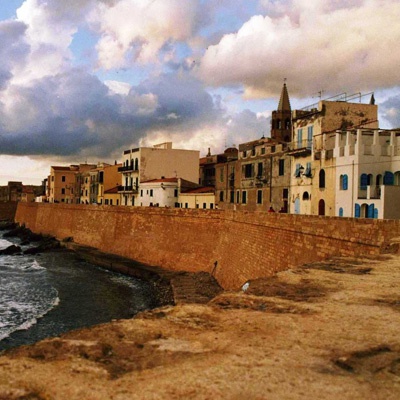
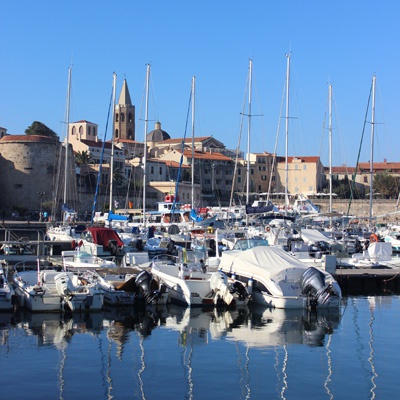
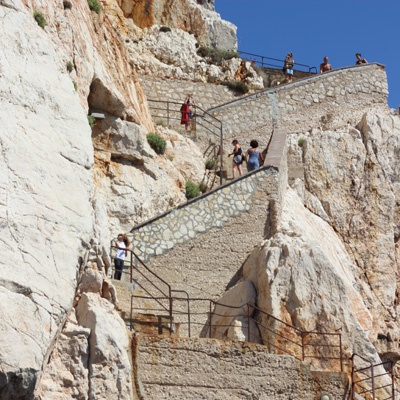
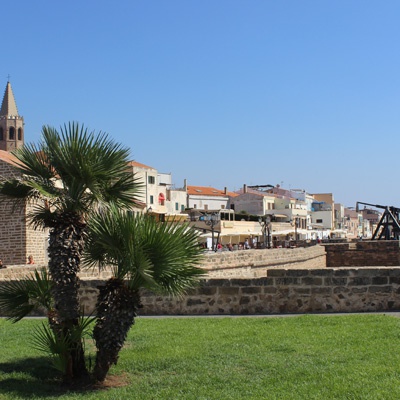
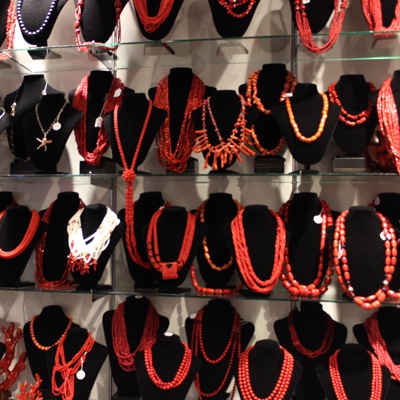
Alghero, l'Alguer in Catalan, S'Alighera in Sardinian, a Sardinian of 44,111 inhabitants. It is also known as Barceloneta, small Barcelona: the city has indeed retained the use of the Catalan language.
The territory of Alghero hits history during the Neolithic (VI-VI millennium BC) and uman life has always been present in its territory (domus de Janas, the necropolis of Anghelu Ruju, 90 known nuraghi and tombs of the giants). Scarse fenician presence, and life continues with no apparent interruption through Cartaginensian and Roman times.
Modern Alghero was founded in the early twelfth century, by the Doria family of Genoa. in 1297, according to the wishes of Pope Bonifacius WII, one realized the first nucleus of the Kingdom of Sardini and Corsica and began the history of the Aragonese Sardinia. In 1350 the Doria sold their rights to Peter IV of Aragon, who was busy giving borders to newborn Kingdom of Sardinia. In 1355 the city was recognaised the coat of arms as a "Free City". On August 28, 1501 it was awarded the title of Royal City.
In 1720 the Kingdom of Sardinia passed to the House of Savoy. This lead to no cultural or linguistic change in Alghero.
Alghero has many worthwhile visiting historical sites: the Roman ruins, Anghelu Ruju, Nuraghe Palmavera, the church of San Francesco, dating from the fifteenth century, St. Michel church, with its colored tiles dome, ond the Orthodox Church of St. Barbara.
Walking hrough its narrow streets, you will notice many shops with a wide selection of coral jewelry. The Alghero's coral is rinowned as one the finest in the Mediterranean for quality, compactness and especially for its ruby red color. Coral is one of the most important economic aspects of Alghero's territory, the Coral Riviera. The emblem of the city figure has a branch of the precious red coral on a foundation of rock. For the particular combination with the jewelery and goldsmith craft is also called red gold, so much so that it is sold at the same price of the precious metal.
Animal, vegetable or mineral? In fact, corals are skeletal remains of organisms related to marine life.
In ancient Rome, corals were regarded as marine plants, probably because they are really very similar to the sprawling branches of the trees. In ancient Greece, the coral origin is associated with the myth of the Gorgons - monsters that live in the dept of the sea. Supposedly thay banish the evil eye and protect newborns; certainly, wearing a coral necklace means carrying with you a sort of sublime solidification of the sea: an ancestral gift come from the murky depths to rest on spotlrss baby's skin.
The Coral Museum Alghero, within the beautiful Villa Constantine, gives ud an account of this long social, economic and artistic history, beginning from prehistory and early history, when the use of coral stood with clear cultural meanings: the coral referred to blood and, thereby, to life itself.
To discover this mysterious world you can visit a workshop where, since four generations, artisans work coral to create unique jewelry. Coral, harvested as a flower of the sea, gets a second life in this juwelers laboratory. The skill stays in being able to identify, from a raw coral brunch, the object to be achieved with the list waste of the precious material. To work the corals few are the tools needed. All is entrusted to the hands of the artist who with skill and craftsmanship must achive what his immagination has dictated him. In fact, the most successful works are the result of a happy alchemy of technique and creativity, when the imagination can grasp the peculiar shapes that coral suggests.
You may be intertained by the shop windows of small boutiques and craft shops, by a medieval churche, by shopping in the winding streets of the old town, or by the many Catalan flags and the indescribable view of the waterfront but, after visiting the city, you might start to feel like tasting some of he most delicious local dishes: antipati like capunara or bottarga for starter, followed spaghetti with sea urchins, the delicious lobster Catalan, or the hot and spicy agliata, all accompanied by great white wine, and finally the sweets seadas and papassinos, and, to help digestion, a shot of "limoncello" or fantastic cold fresh "mirto di Sardegna", perhaps the most famous Sardinian aperitif .....
Alghero will enchant you at first sight and leaving you with the vivid memories that will stay with you for a long time!
The tour last half a day (up to 4 hours)
walking tour + transfer